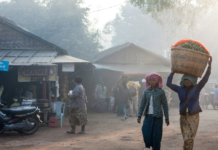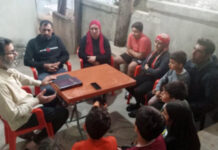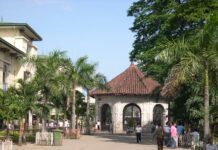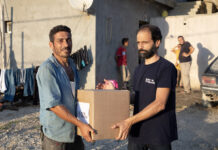By Michael Ireland, Chief Correspondent, ASSIST News Service (www.assistnews.net)
SOUTH-EAST ASIA (ANS – Oct. 11, 2018) — On a ‘tea estate’ in South-East Asia, the long, snakelike trunk searched the ground, looking for consumables, and two ivory tusks protruded from the mouth of this king of beasts, four legs, like tree trunks, supported the mammoth body as it moved through the familiar domain, and Mudit’s heart sank at the sight.
There was nothing Mudit could do to stop the elephant from eating its way through his small plot of farmland on the ‘tea estate’ in South-East Asia.
As Mudit realized his time, effort and investment had been wasted yet again, despair etched itself deeper into the elderly father’s heart. How could he ever provide food for his ‘tea estate’ children?
A Community Bereft
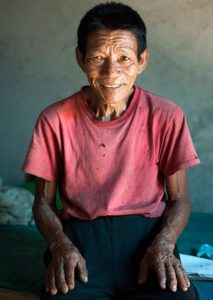
Mudit lived near a tea estate with thousands of other families. For years, their primary occupation had consisted of harvesting and processing tea leaves. The wages were never spectacular; sometimes they were barely enough for each family to survive. Then the estates started to close.
The communities quickly deteriorated as families struggled to make ends meet. Teenagers turned to thievery, cutting down public trees for lumber and stripping the area of metal to sell for scrap. Some families moved away, seeking to find a fresh start elsewhere. Many who remained took the daily risk of traveling in search of work, potentially wasting a day and travel expenses if work wasn’t available.
Mudit, despite being 65 and unable to do much physical labor, soon found himself among that group. If he found work, he could earn a small amount every day, but that only happened three or four days a week.
“I struggled to provide for my children’s education, for their clothing and food,” Mudit explains. “If anybody is sick at home, I have to borrow money from people.”
He endeavored to grow potatoes and other vegetables to feed his young children, but wild elephants would occasionally help themselves to the produce from his small plot of land.
“I am not able to buy enough food for the children,” Mudit says. “What we have, we try to manage with that.”
Helping as Much as They Can
The local government school fed several children a daily meal, but not every child could afford to enroll; the price of notebooks and other supplies might be a week’s worth of the family’s wages. Many children labored alongside their mothers and fathers instead. Mudit’s eldest son, Patag, only 13, was among them, while his two younger sons, Titir and Binod, found themselves on a happier path.
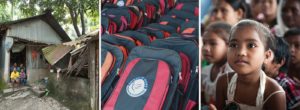
Seeing the desperate situations of many parents and children, a group of GFA-supported workers started a GFA-supported Bridge of Hope center in the area, hoping to alleviate the strain of several families. At the center, 120 children would receive a daily meal, school supplies, clothing and toiletries, along with compassionate care from the social workers and teachers.
“Now my two children Titir and Binod go to our Bridge of Hope project center, and that has been a great help for my family,” Mudit shares, “because they are given every basic thing that my children need, including food. … I would never be able to buy any of those things for my children and for their education. This has been a great help for me.”
Only the Beginning
The transformation in Mudit’s children is more than just full bellies and new clothes. Children in Bridge of Hope centers across Asia have found freedom to pursue dreams of becoming doctors, engineers, teachers and officials. Through the tutelage and attention they receive, children have the opportunity to excel and bless their communities in many ways.
“Bridge of Hope has taught them so many good things,” Mudit shares. “I can see the change and the development in their thinking. If Bridge of Hope had not been there, I think my children would have discontinued going to school [by] now. They would be roaming here and there . . . but now they are changed and happy. They always want to go to school.”
Although the Bridge of Hope center has already made a difference in the lives of Mudit’s family, many others still struggle. There are thousands of children living in or near the tea estates. Thousands of children who know the struggle for survival.
“There is no way possible to help each family or each individual,” shared a local GFA-supported worker. “I would say 25–30 Bridge of Hope centers in [these] tea gardens is not going to be enough.”
Through all the challenges, the work is just beginning, and for now, at least 120 children in the tea gardens have a chance for a better future through Bridge of Hope.
We don’t yet know how Titir’s and Binod’s stories will end—their journeys with Bridge of Hope are just beginning. But they will have enough food, love, care and guidance to carry them through another day, no matter how many other dangers are prowling around.
At Gospel For Asia’s-supported Bridge of Hope centers, 70,000 children across Asia are receiving free education, food and medical care—and ultimately discovering a new way of life!
The Unsponsored Children Fund supplements the lack of resources when children in Asia don’t have the sponsors they need to stay in a Bridge of Hope center.
But many Bridge of Hope children do not currently have a sponsor, while millions of other impoverished children have never even set foot in a school and are going to bed hungry.
How can these children receive the care they need?
GFA’s Unsponsored Children’s Fund helps children by:
- Funding the education and care for children who have no sponsor.
- Enabling Bridge of Hope staff members to immediately enroll extremely needy children while we search for a permanent sponsor.
The Unsponsored Children’s Fund supplements the lack of resources when students don’t have the sponsors they need. It provides for their meals, their school supplies, their medical checkups and many of their other needs. Our dream is to one day rescue 500,000 children!
You can help families like those of Mudit and his children here: https://www.gfa.org/ministries/unsponsored-childrens-fund


